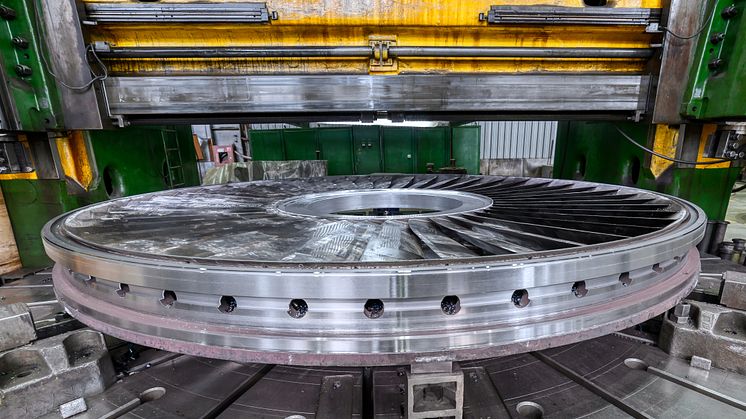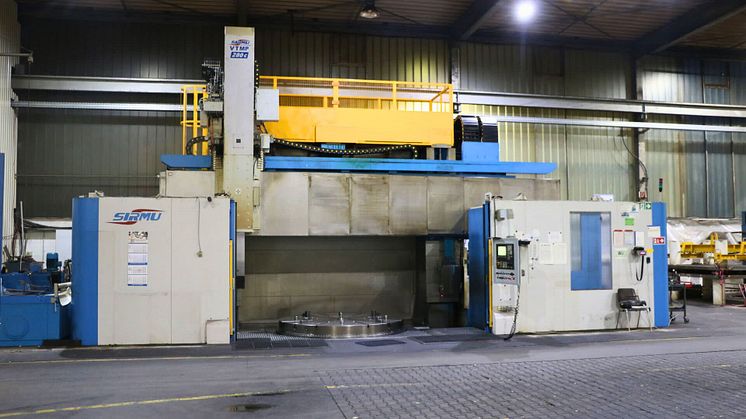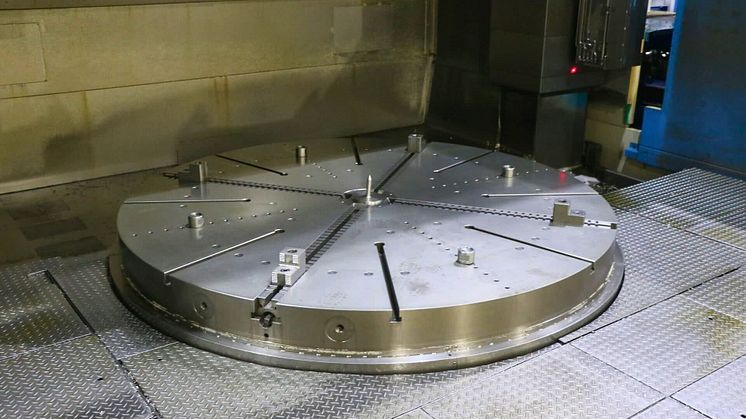
Press release -
Precision work in XXL: 7 facts about vertical turret lathes
How are gears for heavy industry – 16 m in diameter and 500 t in weight – manufactured? On a vertical turret lathe. These special lathes are used whenever large and heavy workpieces need to be produced with the utmost precision. The following overview explains the technical fundamentals of vertical turret lathes in seven facts.
Fact 1: Vertical turret lathes process particularly large workpieces.
Vertical turret lathes are a special type of vertical lathe specifically developed for machining large and heavy workpieces. Unlike classic lathes with a horizontal spindle and lateral machining of the workpiece, vertical turret lathes enable the production of large turned parts through their vertical working method.
Vertical turret lathes are characterised by a horizontally rotating faceplate on which large workpieces are centred. This clamping surface facilitates the handling of large and heavy components. Often, these machines have faceplates with diameters of over 5 m – sometimes even over 10 m. Due to mostly hydrostatic slide bearing of the faceplate, it can hold extremely heavy turned parts of over 100 t. Vertical turret lathes are therefore particularly suitable for machining large, round workpieces, such as a turbine or pump impeller.
Fact 2: Vertical turret lathes operate with high precision.
Despite their considerable size, vertical turret lathes excel in precision, making them ideal for complex manufacturing processes. A key advantage of these machines is the ability to precisely machine workpieces in their final installation position, as they are mounted on the horizontal faceplate in this exact orientation. Particularly precision-demanding workpieces are machined in a single setup, as every re-clamping reduces accuracy.
Vertical turret lathes are differentiated into two designs: the single-column and the double-column (or portal) design. In the single-column variant, a crossbeam is attached to one column with the tool mounted on it. The double-column or portal design, on the other hand, consists of two columns and a crossbeam with tools. This construction is particularly robust and thus characterised by high precision. Typical values for positioning accuracy are around 0.006 mm/m and for repeatability around 0.0035 mm/m.
Fact 3: Vertical turret lathes are efficient due to shorter machining times.
With multiple spindles attached to the crossbeam, machining time is reduced by using various tools in parallel. Especially in the double-column design, up to three independent turning tools can be used simultaneously. The use of an automatic tool magazine allows for rapid tool changes, thereby reducing downtime. Moreover, the design of these machines often allows for less frequent re-clamping of workpieces.
Fact 4: Vertical turret lathes have a long history.
The history of vertical turret lathes dates back to 1839. At that time, Swiss engineer Johann Georg Bodmer developed the first lathe with a vertical spindle and horizontal faceplate in England. By the end of the 19th century, these machines had become popular in the USA and later in Europe. They were available in various designs – including single-column and double-column versions, with fixed or movable columns, and equipped with multiple tool carriers.
In the 1930s, the production of larger water turbines led to the development of large double-column vertical turret lathes with movable portals. The impressive faceplate diameters reached up to 18 m. After World War II, the open single-column vertical turret lathe initially prevailed. However, today they are less commonly used than the double-column variant due to construction-related disadvantages in accuracy and machining performance.
Fact 5: Vertical turret lathes are suitable for single-part and small-series production.
Due to their design and size, vertical turret lathes are particularly suitable for machining single parts and small series – especially since large parts are usually not mass-produced. As the workpieces can be machined with only one setup and thus multiple re-clamping is eliminated, vertical turret lathes are also suitable for efficient production of small series.
Fact 6: Vertical turret lathes are used in versatile areas.
Vertical turret lathes are used in a wide range of industrial sectors. They are standard in aerospace, energy technology, steel industry, and offshore technology. In addition, they play a crucial role in general mechanical engineering and are also of great importance in turbine and apparatus construction. Vertical turret lathes are excellently suited for machining various materials such as castings, forgings, welded constructions, and aluminium parts. Some models can also be equipped with milling and grinding tools, which expands their application range. Typical complex components manufactured on vertical turret lathes include turbine blades, impellers, large gears, or pressure vessels for nuclear or chemical reactors.
Fact 7: Vertical turret lathes are expensive to purchase.
The acquisition of a vertical turret lathe involves high costs due to its size, complexity, and technical capabilities. Therefore, many companies opt for the purchase of used machines as a cost-effective alternative. An example is the SIRMU VTMP 280 C, a double-column vertical turret lathe offered for direct sale on the Surplex.com platform. With a faceplate diameter of 2.8 m and a maximum workpiece weight of 42 t, this machine is among the medium-sized models. It is additionally equipped with turning, milling, and grinding heads – the latter, however, needs to be serviced. The machine is located in Kreuztal, Germany. The VTMP series is appreciated for its combination of precision, high machining performance, and rigidity. Offers like these enable companies to access advanced manufacturing technology at a fraction of the cost of new equipment.


Related links
Categories
About Surplex
Surplex is one of Europe’s leading industrial auction houses and trades worldwide in used machines and factory equipment. The 18-language auction platform Surplex.com is visited around 50 million times every year. It sells more than 55,000 industrial products per year in over 800 online auctions. The company is based in Düsseldorf and has offices in 16 European countries. Over 220 employees from 20 different nations generate an annual turnover of more than 100 million euros.




